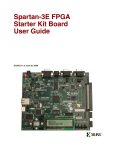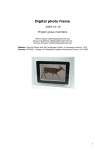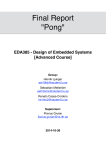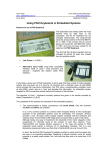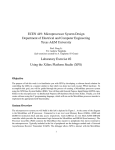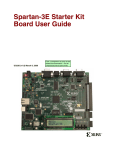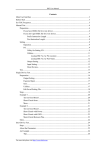Download Text video Terminal
Transcript
Text video Terminal EDA385-Embedded system Design – Advanced Course Ruiyi Zhang (sx07rz1) Liding Zhao (sx07lz9) Ling Ma (sx08ml4) 1 Abstract This report documents the development of embedded video terminal that runs on a Xilinx Spartan-3E FPGA (XC3S500E-4FG320C) FPGA on Spartan-3E Starter Development Board. This project is developed under the environment of Xilinx ISE and Platform Studio. The system includes Xilinx provided hardware, custom VHDL IP and a Microblaze microprocessor, on which the c program were running. The characters inputted by ps2 keyboard will be displayed on the VGA monitor. 2 Contents 1. Introduction.……………………………………………………………………..4 1.1 VT100…………………………………………………………………………………..4 1.2 Hardware platform……………………………………………………………………...4 1.3 Contribution……………………………………………………………………………..5 2. Hardware.………………………………………………………………………….6 2.1 PS/2 controller…………………………………………………………………………..6 2.2 VGA text controller……………………………………………………………………..6 2.2.1 VGA synchronization……………………………………………………………….....7 2.2.2 VGA text……………………………………………………………………………….8 3. Software.…………………………………………………………………………..12 3.1 Scan code……………………………………………………………………………….12 3.2 Scan code receiving and processing …………………………………………………....13 3.3 VGA displaying program………………………………………………………………..13 4. Conclusion………………………………………………………………………...15 4.1 Lesson learned…………………………………………………………………………...15 4.2 Further work……………………………………………………………………………..15 4.3 Installation and user manual……………………………………………………………..15 3 Chapter 1 Introduction 1.1 VT100 VT100 is a video terminal which was made by Digital Equipment Corporation (DEC). It became the first standard used by terminal emulators [2]. It was introduced in August 1978, following its predecessor, the VT52, and communicated with its host system over serial lines using the ASCII character set and control sequences standardized by ANSI. The VT100 was also the first Digital mass-market terminal to incorporate "graphic renditions" (blinking, bolding, reverse video, and underlining) as well as a selectable 80 or 132 column display. All setup of the VT100 was accomplished using interactive displays presented on the screen; the setup data was stored in non-volatile memory within the terminal. The VT100 also introduced an additional character set that allowed the drawing of on-screen forms. Figure 1a shows the prototype of video terminal. Figure 1a Figure 1b [3] 1.2 Hardware Platform The video terminal project was implemented on the Xilinx Spartan-3E starter board. The target board is a Xilinx Spartan 3E Starter board shown in figure 1b with the following specifications: Microblaze microprocessor BRAM PS2 Controller VGA Text Controller UART GPIO 4 The hardware architecture is based on PLB Bus. The Microbalze processor is master of the bus, PS2, UART and VGA text controller are slave device. UART controller connected to the hyper terminal is used as debug console. The block diagram is shown as below in Figure 2. Figure 2. Block diagram of Hardware 1.3 Contribution Hardware: Ruiyi Zhang and Liding Zhao Software: Ruiyi Zhang and Ling Ma Integration and Testing: Everyone Report: Everyone 5 Chapter 2 Hardware 2.1 PS/2 controller PS/2 controller is used to receive scan code from ps/2 keyboard and the scan code is written into memory mapped register. Microblaze processor can get the scan code through read these registers. The keyboard uses a serial protocol with 11-bit frames, as illustrated in figure. These bits are: 1 start bit. This is always 0. ●8 data bits, least significant bit first. ●1 parity bit (odd parity). ●1 stop bit. This is always 1. Figure 3[1] In this project, we use ps/2 controller of Xilinx IP core at last. Although we created our own hardware of ps/2 controller, it is not very stable under polling mode. It would be quite time consuming to debug it connected to PLB Bus. Therefore, we decided to use Xilinx IP to save time to continue the project. 2.2 VGA text controller The VGA port of Xilinx Spartan-3E starter board has five active signals, including the horizontal and vertical synchronization signals, hsync and vsync, and three video signals for the red, green, blue color. It is connected to a 15-pin D-sub connector to display 8 different colors. The hsync and vsync signals are used to control the horizontal and vertical scans of the monitor. A VGA controller generates the synchronization signals and outputs data pixels consequently. In our design, VGA controller is divided into two components: synchronization circuit and text generation circuit. The first circuit generates the timing and synchronization signals. The second one generates three RGB video signals [4]. The VGA text controller block overview is show in figure 4. 6 Figure 4 2.2.1 VGA synchronization VGA synchronization circuit generates the horizontal sync signal, which specifies the time to traverse a row, and the vertical sync signal, which specifies the time to scan the entire screen. In our VGA specification, a resolution of 640-by-480 with 60Hz refresh rate. Figure 5 7 According to the above figure from Xilinx VGA system timing specification, a period of the horizontal sync signal has 800 pixels and can be divided into four regions: Display: In this region, pixels are actually displayed. The length of this region is 640. Retrace: Video pixels are disable during this region. The length is 96. Front porch: Region forms the right border of display. The length is 16. Back porch: Region forms the left border of display. The length is 48. Therefore, horizontal sync signal can be obtained by mod-800 counter. This signal goes low when pixel is between 656 and 751. As same with horizontal sync signal, vertical sync signal has 521pixels and can also be divided into four regions: Display: In this region, pixels are actually displayed. The length of this region is 480 lines. Retrace: Video pixels are disable during this region. The length is 2 lines. Front porch: Region forms the bottom border of display. The length is 10 lines. Back porch: Region forms the top border of display. The length is 33 lines. For a 640-by-480 resolution and 60 Hz refresh rate, the pixel rate can be calculated as below: P = 800 (pixels/line) L = 521 (lines/screen) S = 60 (screens/second) Pixel rate = P*L*S = 800*521*60 = 25.008M (pixel/second). Here, we use the Microblaze and PLB bus frequency clock of 50MHz. Then, half of their frequency clock can be exactly used for VGA controller by half frequency divider. Another way is that to connect PLB Bus clock signal directly by setting the PLB bus running at 25MHz. 2.2.2 VGA text One method to construct a text display is to treat the characters as tiles and design the pixel generation circuit using the tile-mapped scheme. A tile can be treated as a super pixel. There is a example of character A. In the figure a, A is displayed like this pattern, the figure b is the binary pattern to generate A. In the right figure, ‘0’ stands for dots to be blanked, ‘1’ stands for dots to be lighted. Some software are quite useful to generate hex according to the characters or simple pattern. 8 0 0 0 0 0 0 0 0 0 0 0 1 1 0 0 0 0 0 0 0 0 0 0 0 1 1 1 1 1 0 0 0 0 0 0 0 0 1 1 1 1 1 1 0 0 0 0 0 0 0 0 1 1 1 1 0 0 0 1 0 0 0 0 0 0 0 0 1 1 1 1 0 0 0 1 0 0 0 0 0 0 0 0 0 0 1 1 1 1 1 1 0 0 0 0 0 0 0 0 0 0 0 0 0 1 1 1 1 1 0 0 0 0 0 0 0 0 0 0 0 0 0 0 1 1 0 0 0 Figure 6 a Figure 6 b The patterns of the tiles constitute the font of the characters. An 8-by-16(8-column and 16-row) font is chosen in this project. In this font, each character is represented as 8-by-16pixel pattern. For the display, the 7-bit ASCII code is used for the character tiles [4]. One 8-by-16 pattern needs 16 bytes, that is, 2 7 bits. Because of 7-bit ASCII code, there exist 2 7 kinds of pattern. Therefore, a ROM stored these patterns needs 214 bits. If the ROM is addressed in byte, there will be 211 bytes in total. If these 8-by-16 charters are used in 640-by-480 resolution screen, 80 characters 640 480 ) can be fitted in one line and 30 lines ( ) can be fitted into one screen. ( 8 16 In the 211 bytes ROM, seven MSBs of the 11-bits address are used to address the characters and four LSBs are used to identify the row within a character. 9 Figure 7 Text circuit architecture is show in figure, it is made up two components. The first one is dual port memory, which has one port for writing and one port for reading. The writing port connected to PLB register. Once Microblaze writing to this register in the four fields, that is x and y position of character and ASCII code of character and write enable. This register can be set to 32 bits (bit 31 to 24 is stored for position y, bit 23 to 16 is stored for position x, bit 15 to 8 is stored for ASCII code, bit 7 to 0 is stored for write enable). As the figure shown, in the writing port of memory, five bits of psn_y and seven bits of psn_x form twelve bits address of writing and seven bits ASCII code is the data of input. Another address of read port is connected to upper bits of pixel_x and pixel_y, which are generated by synchronization circuit. The read output data is ASCII code of every saved character. This character ASCII code together with three lowest bits of pixel_y is used to address the byte of font ROM. In the last stage, three lowest bits of pixel_x is the input signal of 8-to-1 MUX to select every pixel of this byte. A cursor is included to mark to current location of entry and the cursor block keeps the track of current location of cursor. Table summarizes the resource utilization for PS/2 controller and VGA text controller blocks created for this project. 10 PS/2 controller Resources Number of Slices Number of Slice Flip Flops Number of 4 input LUTs Number of BRAMs Used 275 out of 4656 370 out of 9312 421 out of 9312 0 out of 20 Utilization 5% 3% 4% 0% Used 155 out of 4656 229 out of 9312 162 out of 9312 3 out of 20 Utilization 3% 2% 1% 15 % VGA text controller Resources Number of Slices Number of Slice Flip Flops Number of 4 input LUTs Number of BRAMs We can see that most components of the VGA text controller hardware are RAM, which are used as memory and ROM. 11 Chapter 3 Software Based on hardware architecture, software mainly consists of two parts: one is that PS/2 keyboard scan code receiving and processing program, the other one is VGA displaying program. 3.1 Scan code According to PS/2 keyboard specification, three types of key activities are observed: ●When a key is pressed, the make code of the key is transmitted. ●When a key is pressed down continuously, the make code is transmitted repeatedly at a specific rate. ●When a key is released, the break code is transmitted. For instance, when A is pressed and released, the keyboard first transmit its make code and then the break code: 1C F0 1C. As can be seen that 1C is the make code and F0 1C is the break code. If we hold the key down for a while and then release it, the make code will be sent several times: 1C 1C 1C … 1C F0 1C. One case should be concerned is that multiple keys can be pressed at same time. For example, @ character is obtained by pressed shift and 2. We can first press shift key (scan code is 12) and then the 2 key (scan code 1E), and release 2 key and then shift key. The total scan code sequence is 12 1E F0 1E F0 12. Another case also needs concerned is that make code of some keys is four bytes instead of two bytes, which are known is extended keys. For example upper arrow is E0 75. Upper case character can be obtained by two ways, one is that press shift key and corresponding lower case key and then release them. Another way is that press and release caps lock key first, then press the corresponding lower case key. All the cases mentioned above are needed to treat differently. In the program, normally we use judgement and flag to make them separately 12 3.2 Scan code receiving and processing Polling method is used to receive the scan code, read scan code repeatedly until scan code is not equal to 0x00 to jump out of the loop. The flow char of receiving is shown as below in figure. Setup PS/2 Receive Scan Code Yes Scan Code == 0x00 No Saving Scan Code Figure 8 The received scan code is processed according to different code. For example, different process will be done on whether the key belongs to a-z or 0-9 or shift or caps and etc. The flow char of scan code processing is shown as below in figure. 3.3 VGA displaying program The main idea of this program is to record every x and y position of character and cursor after punch the key. For example, after punching the enter key, the cursor will go to head of the next line. In the program, the x position of cursor should be set to 1 and y position of cursor should be plus one. Figure lists some cases of judgment. 13 Yes Scan code is in the range of a-z ? Yes Shift_flag == 1 or Capslock_flag == 1? Ascii code = corresponding small case No Yes Scan code is in the range of 0-9, other printable char ? Yes Shift_flag == 1 ? Switch (Scan code) No Scan code == shift ? Shift_flag = 1 Scan code == caps lock ? Caps_flag = 1 Figure 9 Figure 10 14 Ascii code = corresponding upper case Ascii code = corresponding upper line char Ascii code = corresponding lower line char Chapter 4 Conclusion The project was finished in fulfillment of the course requirements for EDA385, Embedded Systems Advanced Course. It is a very good experience to learn embedded system design and deeply get know to the methodology of hardware/software co-design. 4.1 Lesson learned 1. Use Xilinx IP core as much as possible. Although building your own custom hardware is challenging, you will has to face extra trouble and make more efforts to meet very time-constraint project deadline. 2. If the component used is the IP core of ISE will not be recognized by EDK user_ logic because its library path is not known to specify. In our project, one dual-port memory is used Xilinx-IP core of ISE and it works. When it port to user_logic of EDK, this memory is not recognized because of the library. One solution is to write VHDL code according to the template of dual-port memory provided by Xilinx. 4.2 Further work 1. Implement text processing and editing program which would have the functions such as copy and paste. 2. Make PS/2 mouse compatible. 4.3 Installation and user manual 1. Connect CRT displayer with VGA port and PS/2-based keyboard to the board. 2. Start Xilinx EDK 10.1, open the project file and download it to the FPGA. 3. After downloading, there should be a cursor on the VGA screen and then punch the keyboard to input text. The keys in inside the red line rectangle of below picture are supported. Figure 11 15 Bibliography [1]Adam Chapweske. The PS/2 mouse/keyboard protocol. http://www.computer-engineering.org/ps2protocol/, May 2003. [2] VT100 User Guide. http://www.vt100.net/ [3] Spartan-3E Starter Kit Board User Guide http://www.digilentinc.com/Data/Products/S3EBOARD/S3EStarter_ug230.pdf [4]Pong P. Chu. FPGA Prototyping by VHDL Examples: Xilinx Spartan-3 Version. Wiley, first edition, February 4, 2008. 16


















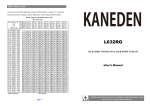
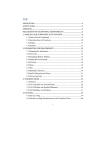

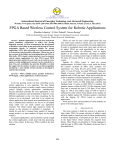
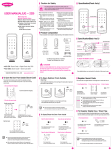
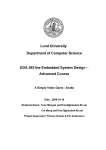
![2008 [DAMN SMALL NAS]](http://vs1.manualzilla.com/store/data/005757702_2-ad0d2f1082977ee9ed587e807bbc0127-150x150.png)

